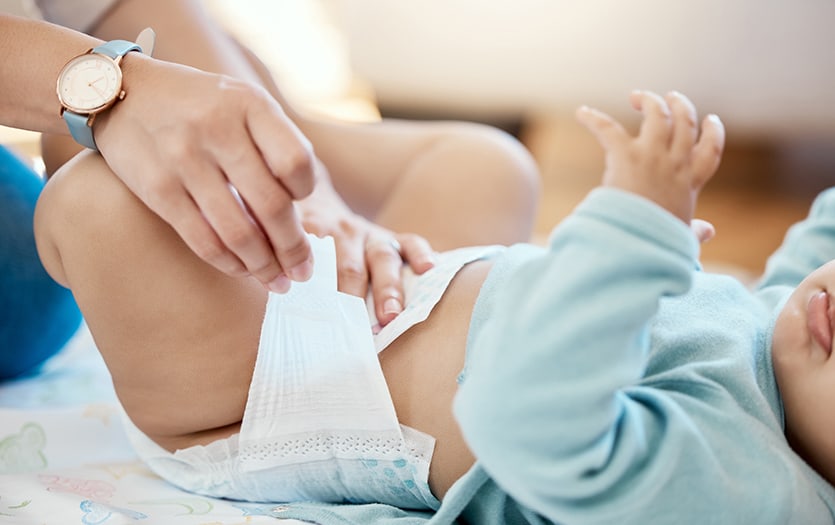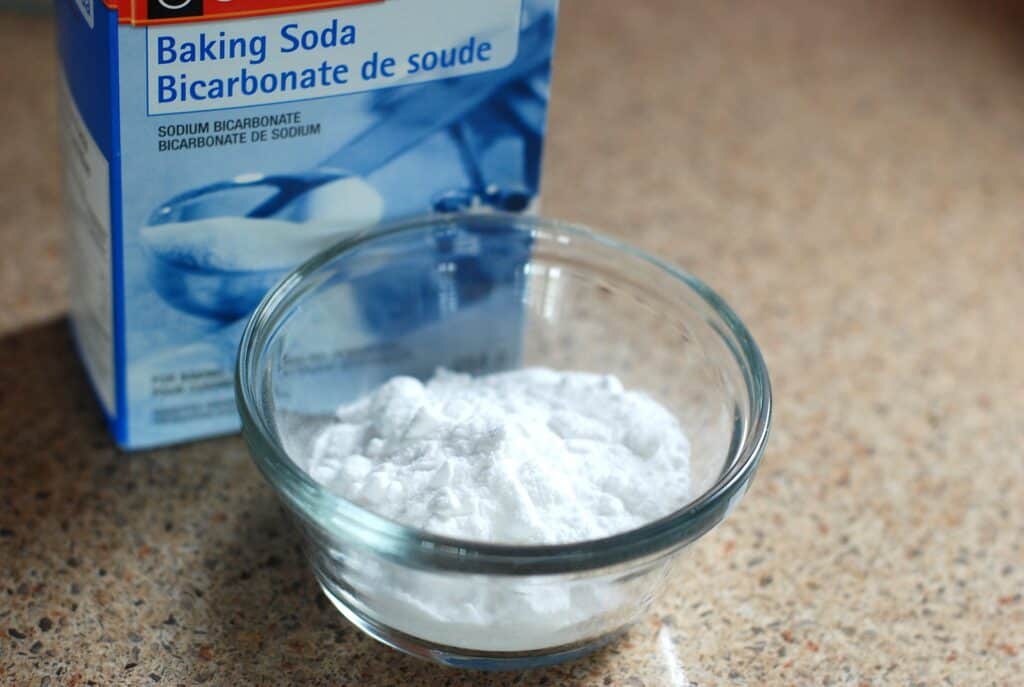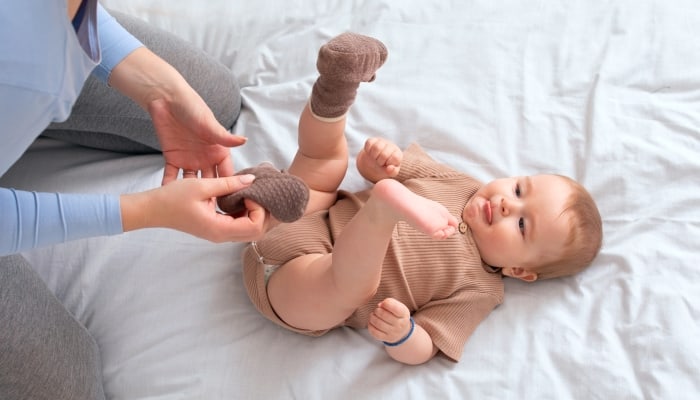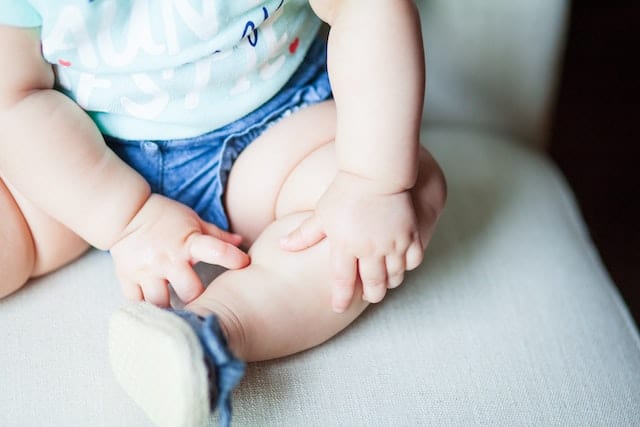Diaper rash is a common problem that affects most babies and toddlers. It causes redness, swelling, and discomfort in the diaper area, and can be caused by several factors such as moisture, friction, and skin sensitivities.
Various home remedies and treatments have been tried and tested over the years to help soothe and heal diaper rash, and one such remedy that is often discussed is the use of baking soda.
Baking soda (sodium bicarbonate) is known for its numerous household and health benefits, ranging from cleaning and deodorizing to neutralizing acidity and relieving inflammation. Given its versatile properties, many parents wonder whether baking soda can be effective in treating diaper rash and providing relief to their little ones.
This article will explore the role of baking soda in treating diaper rash, as well as discuss other effective treatments and precautions.
Key Takeaways
- Baking soda is a versatile substance with potential benefits for treating diaper rash
- There are other effective treatments and care tips for managing diaper rash
- Parents should take precautions and consult a pediatrician when necessary
Understanding Diaper Rash
Diaper rash is a common skin condition that affects babies and infants. It appears as red, irritated skin on the buttocks, thighs, and genital area, causing discomfort and pain for the little ones. The following information will be presented confidently, knowledgeably, neutrally and clearly, in the third person point of view.
There are several causes of diaper rash. The most common cause is prolonged exposure to wetness or moisture, as a wet diaper can create a breeding ground for bacteria and fungi. This moisture can break down the skin barrier and allow irritants to penetrate, leading to inflammation.
Additionally, diapers that are too tight or rubbing against the skin can contribute to diaper rash development.
Another cause of diaper rash is the introduction of new products, such as wipes, creams, or soaps, that may cause an allergic reaction or irritation to the baby’s sensitive skin. Changes in diet, including the introduction of solid foods, can also influence the composition of the baby’s stool and may trigger diaper rash.
Furthermore, general skin conditions, such as eczema or dermatitis, can make a baby more susceptible to diaper rash.
It is important to note that all babies are different, and what causes diaper rash in one infant may not affect another. The key to managing and preventing diaper rash is to keep the baby’s skin clean, dry, and protected.
This can be achieved through frequent diaper changes and using gentle, hypoallergenic products specifically designed for babies. Allowing for some diaper-free time each day to let the baby’s skin breathe can also help in reducing the risk of developing diaper rash.
The Role of Baking Soda
Baking soda, also known as sodium bicarbonate, is a versatile substance that has various applications, from cleaning to cooking. It can also play a role in the care of diaper rash, as it helps to create a clean, dry, and soothing environment for the irritated skin.
One of the key properties of baking soda is its ability to maintain pH balance. It acts as a neutralizing agent, which means it can counteract excessive acidity or alkalinity. Diaper rash is often caused or exacerbated by the presence of acid in the urine or stool, making the skin more acidic.
By gently neutralizing this acidic environment, sodium bicarbonate can help alleviate the discomfort and redness associated with diaper rash.
To effectively use baking soda in addressing diaper rash, it is essential to keep the affected area clean and dry. This can be achieved by changing diapers frequently and thoroughly cleaning the area with mild soap and water. After patting the skin dry, a solution containing equal parts of baking soda and water can be applied to the rash with a clean cloth or cotton ball.
This should be left on for a few minutes before being rinsed off with lukewarm water and again drying the skin gently.
It is worth noting that baking soda may not be suitable for every baby, as some individuals may have a sensitivity to the ingredient. For this reason, it is always recommended to test a small patch of skin before applying it to a larger area affected by diaper rash. If irritation occurs, discontinue use immediately and seek alternative remedies.
In summary, sodium bicarbonate works to maintain the pH balance of the skin, neutralizing the acidic environment often associated with diaper rash. By following proper diaper hygiene and carefully using a baking soda solution, it can aid in the management of diaper rash, providing relief and comfort for the baby.
Baking Soda as Treatment for Diaper Rash
Applying Baking Soda Paste
Baking soda paste can be an effective treatment for diaper rash. To create the paste, simply mix one tablespoon of baking soda with a small amount of water until a thick consistency is achieved. Gently clean the affected area with mild soap and water, then pat dry with a clean towel.
Apply the baking soda paste directly to the diaper rash, ensuring coverage of all irritated skin. Be sure not to rub the paste in, as it could cause further irritation. Allow the paste to dry before putting a fresh diaper on the baby, and repeat the process during each diaper change until the rash subsides.
Using Baking Soda Baths
Baking soda baths can also be a helpful treatment for diaper rash. To prepare a baking soda bath, fill a bathtub or basin with lukewarm water and add approximately two tablespoons of baking soda per gallon of water. Stir the water until the baking soda is dissolved.
Gently place the baby in the bath, ensuring the affected area is submerged, and let them soak for 10 to 15 minutes. It is essential to keep a watchful eye on the baby during this time for safety. Once the bath is complete, carefully remove the baby from the water and pat them dry with a clean towel.
The baking soda bath can be repeated twice daily until the diaper rash heals, but it is important not to overuse the treatment to avoid skin dryness.
Other Effective Treatments
Use of Diaper Rash Creams
Diaper rash creams play a key role in providing relief and healing for diaper rash. There are various types of creams available, each catering to different levels of severity. Most creams contain zinc oxide, which forms a barrier on the skin and protects it from irritants.
One popular cream is Desitin, which contains a high percentage of zinc oxide. This cream works by creating a protective layer to keep the baby’s skin dry and preventing the rash from worsening.
To use diaper rash creams, gently clean the affected area, and apply the cream with a layer thick enough to cover the skin entirely.
Apart from zinc oxide-based creams, there are also creams designed specifically for yeast diaper rash. These creams usually contain antifungal ingredients to effectively combat yeast infections.
Opting for Antifungal Treatments
For yeast diaper rash caused by a fungal infection, antifungal treatments are required. Over-the-counter (OTC) antifungal creams, such as Lotrimin, are an effective remedy for yeast infections. Lotrimin contains an antifungal agent called clotrimazole, which helps kill the yeast responsible for the infection.
To use antifungal creams:
- Clean the diaper area with lukewarm water and mild soap.
- Pat the skin dry with a clean towel.
- Apply a thin layer of the antifungal cream to the affected area.
- Put on a fresh diaper.
Continue the application of antifungal creams as directed by the product label or a healthcare professional. Remember to change diapers frequently and keep the affected area clean and dry to expedite the healing process.
In summary, for diaper rash relief and treatment, using diaper rash creams or antifungal creams can help soothe the symptoms and address the underlying causes.
Zinc oxide-based creams and ointments, such as Desitin, are effective for mild-to-moderate cases, while antifungal creams, like Lotrimin, are necessary for yeast diaper rash caused by fungal infections.
Tips for Managing Diaper Rash
Diaper rash is a common issue among infants and toddlers. It’s essential to address the problem appropriately to prevent further discomfort and complications. Here are some tips for managing diaper rash effectively:
First and foremost, consult a doctor if the diaper rash is severe, persistent, or accompanied by other symptoms like fever. A healthcare professional can provide guidance on the appropriate treatment and care.
Keep the diaper area clean and dry to protect your baby’s skin from irritation. Gently clean the area using a soft washcloth or baby wipes, ideally fragrance-free and hypoallergenic, to avoid causing more redness and irritation. After cleaning, give the diaper area some time to air dry or use a clean, soft towel to pat dry the skin gently.
Frequent diaper changes are essential to maintain a clean and moisture-free environment. Make sure to change wet or soiled diapers as soon as possible to limit the contact between your baby’s skin and potential irritants like urine and feces.
Both disposable diapers and cloth diapers can be used, depending on your preference and your baby’s sensitivity.
To soothe the diaper area, give your baby a warm bath. Avoid hot water, as it can increase irritation, and opt for a lukewarm, gentle soak instead.
Limit the duration and frequency of baths, as excessive bathing can strip away the skin’s natural oils and make the skin more prone to rashes.
Use barrier creams or ointments to protect the diaper area from moisture and irritants. Zinc oxide-based creams are popular choices for their ability to form a protective layer on the skin.
Consider the type of diapers and baby wipes you use. Some babies may be more sensitive to disposable diapers or specific materials in cloth diapers. If you notice an increase in irritation with a certain brand or type, try switching to another option to see if it makes a difference.
Finally, providing your baby with some diaper-free time each day can promote healing and reduce the risk of diaper rash. Allowing the diaper area to air out and breathe can help keep the skin dry and irritation-free. Make sure the environment is warm and safe for your baby, and always keep a watchful eye during this time.
Caring for Babies’ Sensitive Skin
Babies have delicate and sensitive skin, requiring gentle care and attention. When treating diaper rash, it is crucial to use safe and natural remedies, as some commercial products might worsen the condition.
Aloe vera is an excellent natural remedy for irritated skin. Gently apply pure aloe vera gel to the affected area, and let it air dry. Aloe vera’s anti-inflammatory and soothing properties make it an ideal choice for treating diaper rash.
It is also essential to keep the baby’s skin clean and dry. After a bowel movement, clean the area using a soft washcloth and mild soap. Avoid vigorous rubbing as it can further damage the skin. Instead, gently pat the area dry with a clean towel.
Regular application of petroleum jelly can also help protect the irritated skin. It creates a barrier between the baby’s skin and moisture from urine or stool. It is vital to change diapers regularly to minimize exposure to wetness.
Keeping the skin moisturized is another critical aspect of caring for sensitive skin. Using a gentle lotion or olive oil as a moisturizer can help alleviate dryness and enhance skin smoothness.
However, it is crucial to select an appropriate lotion that is fragrance-free and designed for sensitive skin.
Airflow around the diaper area is essential for skin health. Whenever possible, let the baby go without a diaper to provide the skin with ample air exposure. This allows the skin to breathe and helps prevent the formation of rashes.
Lastly, some mothers find success in using breast milk to soothe irritated skin. Applying a few drops of breast milk and allowing it to air dry can potentially alleviate symptoms.
However, ensure that the breast milk is fresh to avoid introducing harmful bacteria to the sensitive skin.
By following these guidelines, parents can ensure that their baby’s sensitive skin remains healthy and free from diaper rash.
Precautions When Using Baking Soda
When using baking soda to treat diaper rash, it is important to take certain precautions to avoid complications. Baking soda has various benefits, such as neutralizing acidity and reducing inflammation. However, improper use can lead to unintended consequences.
Firstly, it is essential to avoid using baking soda if there is a risk of infection. Diaper rash can sometimes be accompanied by yeast or bacterial infections, which can aggravate the condition.
Applying baking soda to an open wound or rash caused by a fungal or bacterial infection can hinder the healing process and potentially prolong the issue.
Moreover, it is vital to consider the possibility of dermatitis, which is a common cause of diaper rash. Babies with sensitive skin can develop dermatitis as a reaction to irritants. In such cases, using baking soda can disrupt the natural pH balance of the skin, exacerbating the rash.
To minimize the risk of complications, always ensure that the affected skin is clean and dry before applying a baking soda solution. Additionally, avoid using baking soda on broken or open skin, as it may cause irritation and slow the healing process.
To prevent the growth of bacteria and yeast, keep the baby’s diaper area clean and dry, and change diapers frequently.
In conclusion, while baking soda can provide relief for some cases of diaper rash, it is critical to use it cautiously. Preventing infections and dermatitis, maintaining the skin’s natural pH balance, and avoiding the application on open wounds are crucial steps in safely using baking soda to treat diaper rash.
When to Visit a Pediatrician
In cases of diaper rash, it is generally recommended to first try treating it at home using various remedies such as applying baking soda. However, there are certain situations in which a visit to a pediatrician is necessary.
If the rash worsens despite consistent home treatment, it is important to seek professional help. A pediatrician can ensure proper diagnosis and provide appropriate medical treatment.
For example, if the rash is caused by a yeast infection, a pediatrician will be able to prescribe antifungal medication.
Parents should also be aware of accompanying symptoms that may indicate a more serious issue, such as a fever persisting for more than 24 hours, blisters or open sores forming on the rash site, or the child displaying signs of illness or distress. In these cases, scheduling an appointment with a pediatrician is crucial.
Moreover, if the child has not previously experienced diaper rash, or if the rash is spreading to other areas of the body, it is advisable to consult a pediatrician. This may signal an underlying condition that requires medical attention.
In conclusion, while most diaper rashes can be managed with home treatments, keep a close eye on the child’s condition, and seek help from a pediatrician when necessary.
Alternative Home Treatments
When treating diaper rash at home, many alternative remedies can be effective in providing relief and promoting healing. For instance, applying witch hazel to the affected area can soothe irritation due to its anti-inflammatory properties.
It also has antibacterial qualities, making it a great choice for addressing the infection that may result from diaper rash. Nonetheless, ensure that the skin is thoroughly dry before putting on a new diaper.
Another option is using apple cider vinegar as an antifungal treatment: mix a tablespoon of apple cider vinegar with a cup of cool water, then gently dab the solution onto the rash with a clean cotton pad. Cool water can also be employed to clean the area and minimize itchiness.
For those seeking a more natural option, yogurt – specifically unsweetened and unflavored – can be applied directly to the skin because it contains probiotics and has cooling properties.
Additionally, natural oils such as cod liver oil and calendula oil can be beneficial for the treatment of diaper rash. Cod liver oil is rich in vitamins A and D, which can help reduce inflammation and enhance skin healing.
On the other hand, calendula oil is derived from marigold flowers and offers anti-inflammatory, antifungal, and antibacterial properties. Make sure to use a small amount of these oils combined with a carrier oil like coconut oil to avoid direct contact with the sensitive skin.
Lastly, creating a homemade diaper rash cream can also be advantageous. A simple recipe involves mixing together equal parts of beeswax, coconut oil, and shea butter, then adding a few drops of essential oil such as lavender or chamomile for additional soothing benefits.
This cream can be applied liberally to the affected area while also creating a moisture barrier for the skin. Remember that beeswax is a natural wax produced by honeybees, making it an excellent emollient and skin protectant.
In sum, various alternative home treatments can alleviate and prevent diaper rash. Employing gentle and natural remedies may prove beneficial in soothing and healing the affected area while avoiding harsh chemicals that could exacerbate the condition.
Over-the-counter Products and Self Care
When managing diaper rash, self care and over-the-counter (OTC) treatments are typically the first line of defense. Most mild diaper rash cases can be treated effectively using such remedies.
The Mayo Clinic suggests caregivers pay close attention to diaper changing frequency, ensuring that babies are changed often to reduce moisture and chafing.
In fact, numerous OTC products can aid in soothing and healing diaper rash. Popular options include A+D, Balmex, and Triple Paste, all of which provide various degrees of protection and treatment.
These creams and ointments create a barrier between the baby’s skin and any irritants, helping to prevent further irritation.
Hydrocortisone ointment is another OTC product that may be applied to reduce inflammation in more severe cases of diaper rash. However, parents should consult a healthcare professional before using hydrocortisone on their babies, as it may not be advisable for all situations.
In addition to using OTC products, caregivers can implement several self care techniques to minimize the risk of diaper rash. For instance, letting the baby’s skin dry thoroughly before applying a new diaper can be helpful. Some parents use a hairdryer or fan to gently dry the area, taking care not to disturb any sensitive skin.
Shampoo clay, also known as bentonite clay, is an alternative self care treatment that may help alleviate the symptoms of mild diaper rash. This natural clay absorbs moisture and soothes irritated skin, making it a suitable addition to the diaper changing routine.
Ultimately, a combination of OTC products and self care measures can effectively treat mild diaper rash and promote healing. By staying proactive and attentive to their baby’s needs, parents can help reduce the frequency and severity of diaper rash while ensuring the comfort and health of their child.
Related Posts:
Frequently Asked Questions
What is the most effective way to use baking soda for diaper rash?
To use baking soda for diaper rash, mix 2 tablespoons of baking soda per 1 quart of warm water. Soak a soft washcloth in the mixture and gently pat it on the affected area during diaper changes. Allow the area to air dry before putting on a fresh diaper.
You may also give your baby a baking soda bath. Allow your baby to soak in a bathtub with warm water and 2-3 tablespoons of baking soda for 10-15 minutes, 2-3 times a week.
How does baking soda compare to other remedies for diaper rash?
Baking soda is a relatively mild and affordable remedy for diaper rash. Its alkaline nature helps neutralize acidity and promotes healing. Other common diaper rash remedies include zinc oxide cream, petroleum jelly, and calendula cream.
Each remedy has its pros and cons, and the effectiveness of various treatments varies depending on the baby’s skin type and the severity of the rash. Consult with your pediatrician to choose the most appropriate remedy for your baby’s needs.
Can baking soda baths help with severe diaper rash?
Yes, baking soda baths can help alleviate the symptoms of severe diaper rash. The soothing properties of baking soda can help reduce inflammation and redness, providing relief to the baby’s irritated skin.
However, for persistent or severe cases, it is advised to consult a healthcare professional for the most appropriate treatment and to rule out other potential causes, such as bacterial or fungal infections.
Is it safe to use baking soda for newborn diaper rash?
Baking soda is generally considered safe for newborn diaper rash when used in appropriate amounts and as directed. However, avoid using it more frequently than recommended, as it can potentially cause skin irritation. Always consult your pediatrician before trying any new treatment for your newborn baby.
What precautions should I take when using baking soda for diaper rash?
When using baking soda for diaper rash, ensure you mix it properly with water, following the recommended ratio. Avoid applying baking soda directly to your baby’s skin or using it on open sores.
Additionally, monitor your baby’s skin for any signs of irritation or worsening of the condition. If the rash does not improve, or if it worsens after a few days of using baking soda, contact your healthcare professional.
How often can I use a baking soda treatment for diaper rash?
You can use a baking soda treatment for diaper rash 2-3 times per week. Avoid using it daily, as this may cause skin irritation. Moreover, remember to continue practicing good diaper hygiene, including frequent diaper changes, allowing the skin to dry thoroughly before re-diapering, and using a barrier cream.
These practices, combined with baking soda treatments, can promote faster healing and prevent recurring diaper rash.

Iesha is a loving mother of 2 beautiful children. She’s an active parent who enjoys indoor and outdoor adventures with her family. Her mission is to share practical and realistic parenting advice to help the parenting community becoming stronger.




